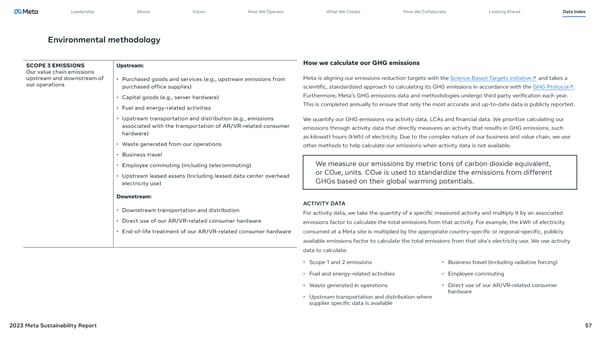Leadership About Vision How We Operate What We Create How We Collaborate Looking Ahead Data Index Environmental methodology SCOPE 3 EMISSIONS Upstream: How we calculate our GHG emissions Our value chain emissions upstream and downstream of • Purchased goods and services (e.g., upstream emissions from Meta is aligning our emissions reduction targets with the Science Based Targets initiative↗ and takes a our operations purchased office supplies) scientific, standardized approach to calculating its GHG emissions in accordance with the GHG Protocol↗. • Capital goods (e.g., server hardware) Furthermore, Meta’s GHG emissions data and methodologies undergo third party verification each year. • Fuel and energy-related activities This is completed annually to ensure that only the most accurate and up-to-date data is publicly reported. • Upstream transportation and distribution (e.g., emissions We quantify our GHG emissions via activity data, LCAs and financial data. We prioritize calculating our associated with the transportation of AR/VR-related consumer emissions through activity data that directly measures an activity that results in GHG emissions, such hardware) as kilowatt hours (kWh) of electricity. Due to the complex nature of our business and value chain, we use • Waste generated from our operations other methods to help calculate our emissions when activity data is not available. • Business travel • Employee commuting (including telecommuting) We measure our emissions by metric tons of carbon dioxide equivalent, • Upstream leased assets (Including leased data center overhead or CO2e, units. CO2e is used to standardize the emissions from different electricity use) GHGs based on their global warming potentials. Downstream: ACTIVITY DATA • Downstream transportation and distribution For activity data, we take the quantity of a specific measured activity and multiply it by an associated • Direct use of our AR/VR-related consumer hardware emissions factor to calculate the total emissions from that activity. For example, the kWh of electricity • End-of-life treatment of our AR/VR-related consumer hardware consumed at a Meta site is multiplied by the appropriate country-specific or regional-specific, publicly available emissions factor to calculate the total emissions from that site’s electricity use. We use activity data to calculate: • Scope 1 and 2 emissions • Business travel (including radiative forcing) • Fuel and energy-related activities • Employee commuting • Waste generated in operations • Direct use of our AR/VR-related consumer hardware • Upstream transportation and distribution where supplier specific data is available 2023 Meta Sustainability Report 57
 Meta 2023 Sustainability Report Page 56 Page 58
Meta 2023 Sustainability Report Page 56 Page 58